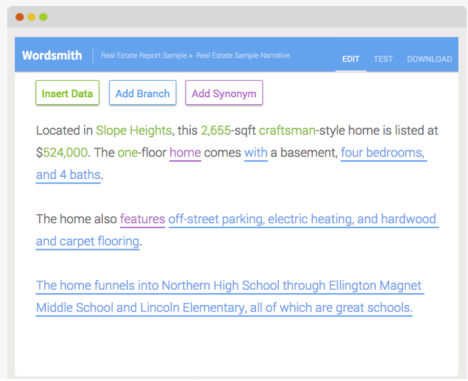The Art of Automation
 In this guest post, Antony Giorgione, talks about the divide between automation and human-generated creative content and how the less creative should start worrying about being replaced.
In this guest post, Antony Giorgione, talks about the divide between automation and human-generated creative content and how the less creative should start worrying about being replaced.
Which image is the fake Rembrandt? On the left is a detail from ‘An Elderly Man in a Cap’. Though it bears Rembrandt’s signature and was painted during the 17th Century it has been reappraised by critics as the work of one of his contemporaries, deliberately rendered in the master’s style.
On the right is a detail from ‘The Next Rembrandt’ – a computer-generated image derived from the analysis of over 168,000 fragments of Rembrandt’s actual work. Its creation is described:
“The process to create the finished 3D-printed painting took over 18 months, following painstaking work involving a team of data scientists, developers and Rembrandt experts.
Analysis of Rembrandt’s work helped experts arrive at the ideal subject for the new portrait, a Caucasian male aged between 30 and 40, with facial hair, wearing black clothes with a white collar and a hat, facing to the right.
A facial-recognition algorithm learned Rembrandt’s techniques, pixel data helped the computer mimic brushstrokes, and an advanced 3D printer brought the painting to life using 13 layers of ink.”
Now consider these two radio scripts;
Denny’s Corporation on Monday reported first-quarter profit of 8.5 million dollars. The Spartanburg, South Carolina-based company said it had profit of 10 cents per share.
The results beat Wall Street expectations. The average estimate of four analysts surveyed by Zacks Investment Research was for earnings of 9 cents per share.
The restaurant operator posted revenue of $120.2 million in the period, also beating Street forecasts. Three analysts surveyed by Zacks expected $117.1 million.
Denny’s shares have risen nearly 6 percent since the beginning of the year. In the final minutes of trading on Monday, shares hit $10.90, a climb of 61 percent in the last 12 months.
and
Denny’s Corporation notched a grand slam of its own in the first quarter, earning a better-than-expected ten cents a share, as restaurant sales jumped by more than 7-percent. Operating revenues topped $120 million. Adjusted net income jumped 36 percent to $8.7 million.
Denny’s is one of the nation’s largest full-service restaurant chains. The growth in sales suggests consumers are opening their pocketbooks for pancakes, eggs, and hash browns. Earnings were also helped by lower costs for raw materials.
Denny’s results were also helped by the re-opening of the high-volume location inside the Las Vegas Casino Royale restaurant. After sales grew faster than expected in the first three months of the year, managers raised their sales forecast for the remainder of 2015.
The first script was generated by Automated Insights’ Wordsmith program, the second by NPR journalist Scott Horsley. Horsley took seven minutes to write his piece, the machine took two, but that’s hardly the point.
The machine’s text comes across with less warmth than Horsley’s, but that’s hardly the point either. As the source article notes, given suffici ent analysis of NPR’s reporting style, the machine would eventually be able to duplicate the house ‘tone of voice’.
ent analysis of NPR’s reporting style, the machine would eventually be able to duplicate the house ‘tone of voice’.
A few weeks ago, Google unveiled artworks from its Deep Dream project.
Though of dubious artistic merit, the pieces shown demonstrated a breakthrough in the quest to replicate the human neural network – more specifically in a machine’s ability to recognise shapes and patterns.
Combine that with the capabilities used for ‘The Next Rembrandt’, add a little Denny’s special sauce, and it seems human intervention need only exist at the barest minimum. Type in a few keywords and the rest is done for you.
These advances in technology bring forward a worrying likelihood for creative professionals. When I consider how much back-end output requires relatively little ‘real’ inspiration; a brochure, an interest-rate MREC, a LinkedIn profile, a Product Disclosure Statement, a display listing, a retail radio script, a 15 second cut-down, etc.
I wonder whether it’ll just be easier for some CMO to rely on automated output derived from sophisticated templating and the vast trove of data supporting or defining their proposition?
I don’t think the supremacy of human-derived creativity is about to be supplanted. In order to create a fake Rembrandt we first need a real Rembrandt to reference.
I remain convinced that the front-end of a campaign or communication initiative will best succeed through brilliant human insight and creative application. I still think David Droga can and will produce incredibly effective marcomms better than any machine.
But at the back-end I think a big chunk of the creative professional’s output is under threat.
‘The Next Rembrandt’ demonstrates a machine’s capacity to synthesise learnings on creativity and reapply them, just as ‘An Elderly Man in a Cap’ demonstrates a human’s ability to do the same.
The majority of the briefs out there are based on a pre-existing brand proposition and tone of voice for delivery through specified channels.
The role of the creative on these briefs is to produce a variant communication within those defined parameters.
My professional pride is not enough to blind myself to the very real possibility that these sorts of back-end tasks could eventually be accomplished by a machine.
‘The Next Rembrandt’ is a marketing exercise by J. Walter Thompson Amsterdam for ING Bank launched earlier this week. Executive Creative Director Bas Korsten states:
“Can you teach a computer how to paint like Rembrandt? All I can say about the outcome is that I see a person. Not a computer image.”
Antony Giorgione is a freelance creative strategist




The real hard-to-replicate trick is lateral thought Even in a copied Rembrandt there is none. Yet the best advertising is full of it – a leap which makes it interesting. To your point, bad run of the mill advertising is ripe with formulaic thinking. So why bother getting humans to do it? I’m sure in the future boring pasta sauce ads will be done by computers. I’ve long questioned why clients even bother going to agencies only to force them to do the same ad we’ve seen for decades.
User ID not verified.
“To your point, bad run of the mill advertising is ripe with formulaic thinking. So why bother getting humans to do it? I’m sure in the future boring pasta sauce ads will be done by computers. I’ve long questioned why clients even bother going to agencies only to force them to do the same ad we’ve seen for decades.” – Unfortunately thats all thats required, product and price. Eventually most agencies will go as marketing departments finally find away to justify their existence, running Algos.
User ID not verified.
@Bon. I agree. What seems to be lacking in these technologies is the ‘associative’ or lateral aspect. To flesh this out a bit, I’m going to reverse engineer one of the images from the google exhibition featuring human face with a dog’s nose. At present, the algorithm has identified ‘nose’ and juxtaposed it as a ‘like for like’ object.
But say you’re a business providing healthcare products for pets, and your ‘front-end’ human derived strategy plays on the idea that your pet may look healthy, but that’s not what’s actually going on inside it (worms maybe). This strategy may be summed up in the line: ‘Is your dog lying to you?’. At some point, it may be possible for the technology to trawl our massive information base, discover that Pinocchio is an analogy for lying, and then produce an image of a dog with an extended snout to run with the headline for a piece of collateral.
This is admittedly a relatively lame ‘concept’, but still one that introduces the lateral aspect to automation. It would be fascinating to see the ideas a computer would generate along these lines – some completely unusable, but others perhaps as obliquely-derived as those from a human. Then it’s down to the CMO to pick a preference.
I think you’ve also nailed the key point, it’s not that we creative professionals may be any less creative, but that the expectations of the clients are determining the relative ‘low grade’ of the communication concept. The difficulty in all this is that there is no consistently demonstrable causation between ‘great creativity’ and effective marketing. In other words, sometimes the mundane (and annoying) works as well.
I don’t think the sky is falling though, as Brad Bennett points out in his excellent piece sitting just above mine in the opinion column; ‘Traditional brand communications are losing their effectiveness on a biological level.’ When the computer can replicate our methodologies, it may be that our perceptive evaluation of the communication has advanced beyond it. The best stand-out work will exist in counterpoint to (or at least alongside) this formulaic and programmatic approach.
Thanks for your feedback.
User ID not verified.
@the future is now. While advances in technology might suggest a reduced workload for agencies down the track, I don’t think every consumer category is going to be led by a pure ‘product and price’ proposition.
User ID not verified.